3M Scotchloks, is my love so wrong?
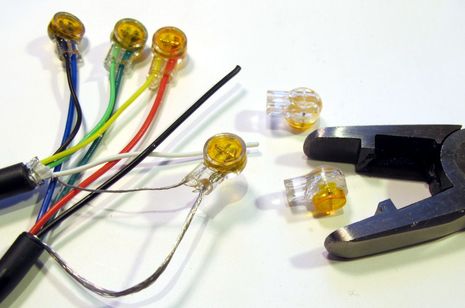 In October I promised to eventually discuss the 3M Scotchlok IDC connectors I used to tap into Gizmo’s engine gauge wires in order to install an Actisense EMU-1 Engine Monitoring Unit. Given that two experienced commenters already strongly dismissed these connectors for boat use, I did more research and testing. Tentative conclusion: while 3M does indeed state that Scotchloks like those tiny UY butt connectors above are meant only for 22-26 gauge solid copper conducter wires, they still seem like the fastest, surest way I’ve seen to splice the fine gauge stranded wires we often deal with afloat. Could it just be a mistake that’s kept a lot of useful Scotchlok models out of 3M’s limited marine line, or did I miss some major difference?
In October I promised to eventually discuss the 3M Scotchlok IDC connectors I used to tap into Gizmo’s engine gauge wires in order to install an Actisense EMU-1 Engine Monitoring Unit. Given that two experienced commenters already strongly dismissed these connectors for boat use, I did more research and testing. Tentative conclusion: while 3M does indeed state that Scotchloks like those tiny UY butt connectors above are meant only for 22-26 gauge solid copper conducter wires, they still seem like the fastest, surest way I’ve seen to splice the fine gauge stranded wires we often deal with afloat. Could it just be a mistake that’s kept a lot of useful Scotchlok models out of 3M’s limited marine line, or did I miss some major difference?
Let’s start at the beginning. What you need to make a lasting wire splice in the boating environment is sufficient mechanical contact between the conductors, a strong connection between the two wires so the contact isn’t broken by vibration or other physical abuse (probably abetted by some form of strain relief), and some sort of protection so that the contact surfaces don’t corrode and fail. The classic first class solution is carefully installed crimped heat shrink connectors as deeply detailed by our friend RC Collins of Compass Marine.
But that solution is quite time consuming and particularly difficult with, say, those 24 gauge NMEA 0183 wires seen in the top photo. I’d love to see some photos and time estimates of how that 5 pair splice is done well with traditional crimp connectors, but can tell you that making those Scotchlok connections — insert unstripped wire pair, snap shut, done — took less time than sorting out the unmatched colors, and I found that regular adjustable pliers could work as well as 3M’s special “crimping” tool.
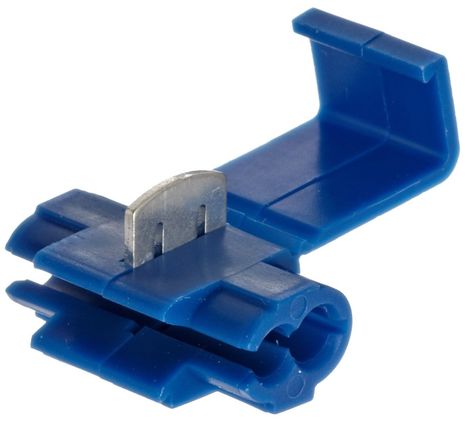 One reason that Scotchloks are unpopular among boaters, I suspect, is that this 801 Instant Electric Connector is probably the first one they experienced. I felt the same way as I’ve seen these things fail fairly frequently, even though they’re still sold as suitable for stranded wire and boats. But the photo does nicely illustrate the essential Scotchlok feature, which is that sliding tin-coated copper “wire insulation displacement contact” with two tapered slots that cut through to the conductors.
One reason that Scotchloks are unpopular among boaters, I suspect, is that this 801 Instant Electric Connector is probably the first one they experienced. I felt the same way as I’ve seen these things fail fairly frequently, even though they’re still sold as suitable for stranded wire and boats. But the photo does nicely illustrate the essential Scotchlok feature, which is that sliding tin-coated copper “wire insulation displacement contact” with two tapered slots that cut through to the conductors.
The 801 also illustrates how well Scotchlok can work as a tap connector you can use to connect a wire to an existing wire without cutting the latter, a trick not possible with traditional crimp connectors. But as one of the first Scotchlok designs, the 801 has a poor mechanism for securing the contact plate down and it offers no corrosion protection.
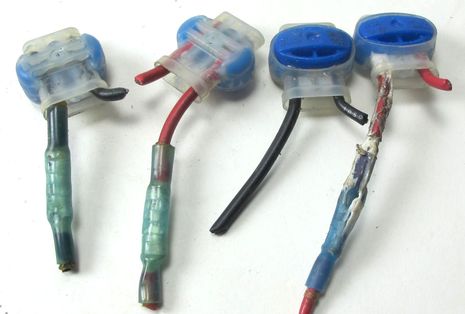
There are more advanced marine Scotchloks like the 314 two or three wire butt connectors above. This particular set was only removed from Gizmo after four years because the varnished running light boards need restoration again; the connectors are near impossible to break open and the anti-corrosive goo inside them seems as gooey as the day I installed them (in a difficult location where traditional crimp connectors would have been a serious pain). These modern Scotchloks also have what’s called a “U-contact,” which means that the plate seen in the old 815 design is effectively doubled. Hence, the contact surface between the wires is also doubled as is the mechanical grip preventing the wires from pulling out.
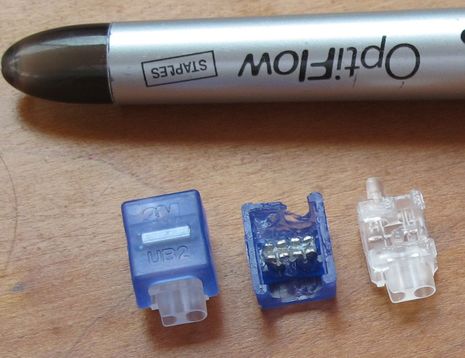 So why aren’t these little Scotchlok UB2 tap connectors also suitable for stranded wire and boats? Honestly, I have no idea. The waterproofing goo — a combination of mineral oil, polybutylene, and dimethyl siloxane — seems to be exactly the same. The doubled contact plate also seems very similar (though I don’t know why there are three slots for a two wire connector). Why would a UB2 be fine for connecting, say, solid core 19-26 gauge wires up on a telephone pole in all weather carrying highspeed DSL communications, but not for low speed stranded wire data connections on a boat?
So why aren’t these little Scotchlok UB2 tap connectors also suitable for stranded wire and boats? Honestly, I have no idea. The waterproofing goo — a combination of mineral oil, polybutylene, and dimethyl siloxane — seems to be exactly the same. The doubled contact plate also seems very similar (though I don’t know why there are three slots for a two wire connector). Why would a UB2 be fine for connecting, say, solid core 19-26 gauge wires up on a telephone pole in all weather carrying highspeed DSL communications, but not for low speed stranded wire data connections on a boat?
Well, I tried hard to unravel this conundrum. The test above, like many others, shows a zero resistance stranded wire connection through what’s supposed to be a solid-wire-only Scotchlok UY butt connector. I had also stripped off the insulation, thinking that might better reveal how the connector didn’t have a solid grip on the stranded 24 gauge wire, but I could tug nearly to the wire’s natural breaking point on either side. And if I’d been more knowledgeable when I ordered these connectors from Allied Electronics, I would have gotten the slightly larger but double plated and more versatile — they can handle 19-26 AWG wires — Scotchlok UY2’s anyway.
At any rate, below is a photo of Gizmo’s main Volvo Penta gauge cluster with six Scotchlok UB2 tap connectors taking tachometer and other sensor info to the EMU-1 and then on to all the NMEA 2000 devices that can now display, log, and alarm the boat’s engine sensors. Installing them was almost trivial – I measured zero ohms of resistance across every connection, and the EMU data was looking fine until I hauled the boat. The only problem is that I’m not supposed to use them in this application. Could it be that 3M just didn’t bother testing these products for the relatively tiny market of marine and automotive small gauge stranded wire use? I’d like to hear your thoughts and also learn about alternatives to my Scotchlok splicing.



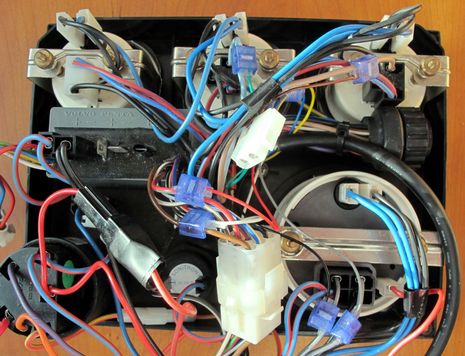
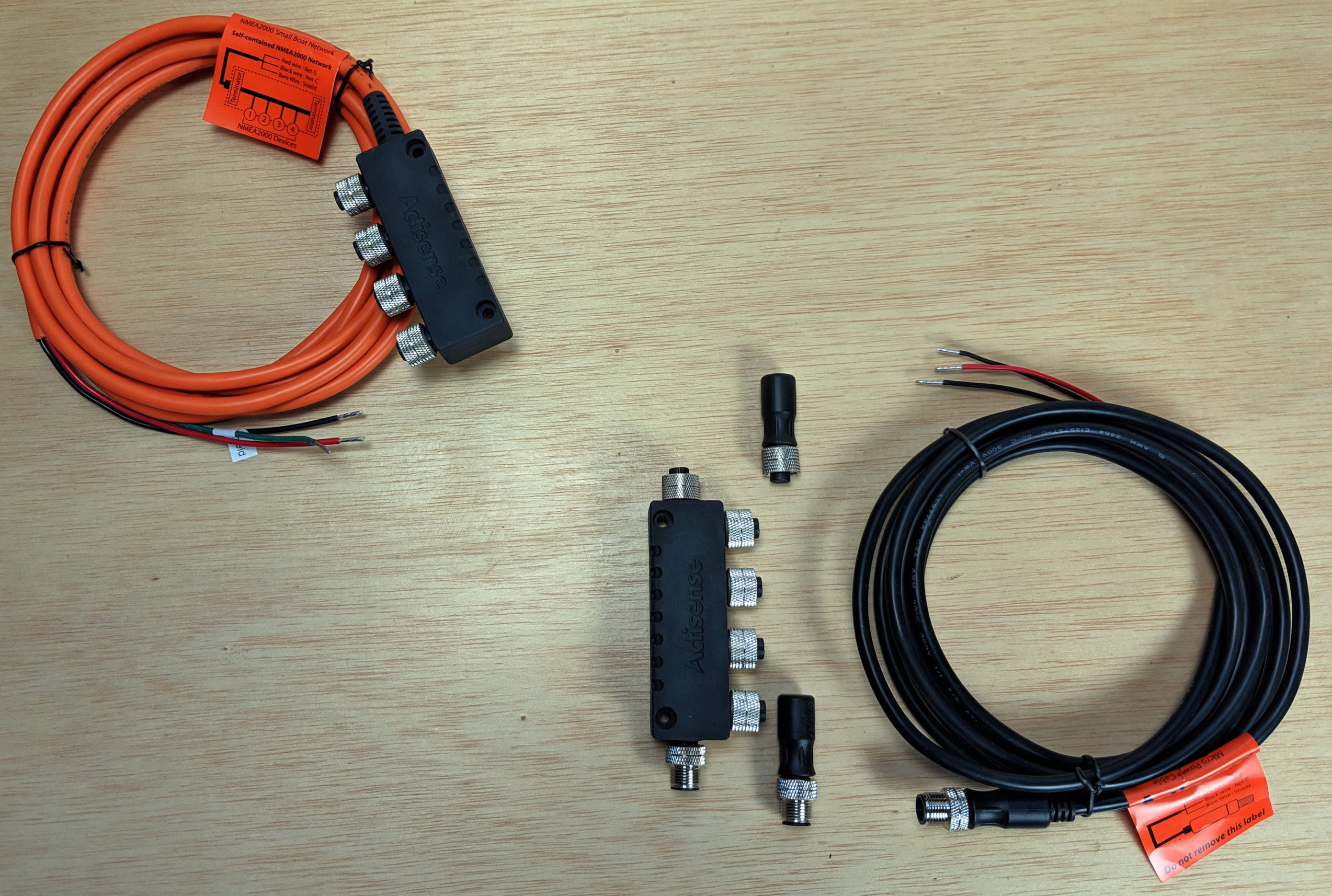
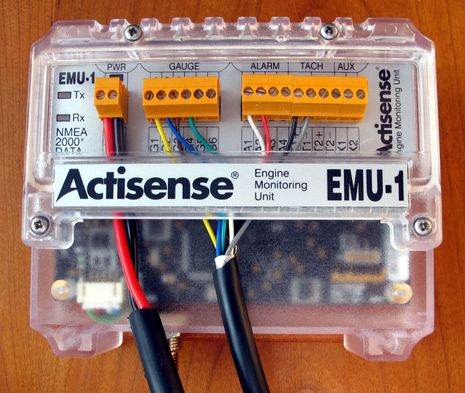

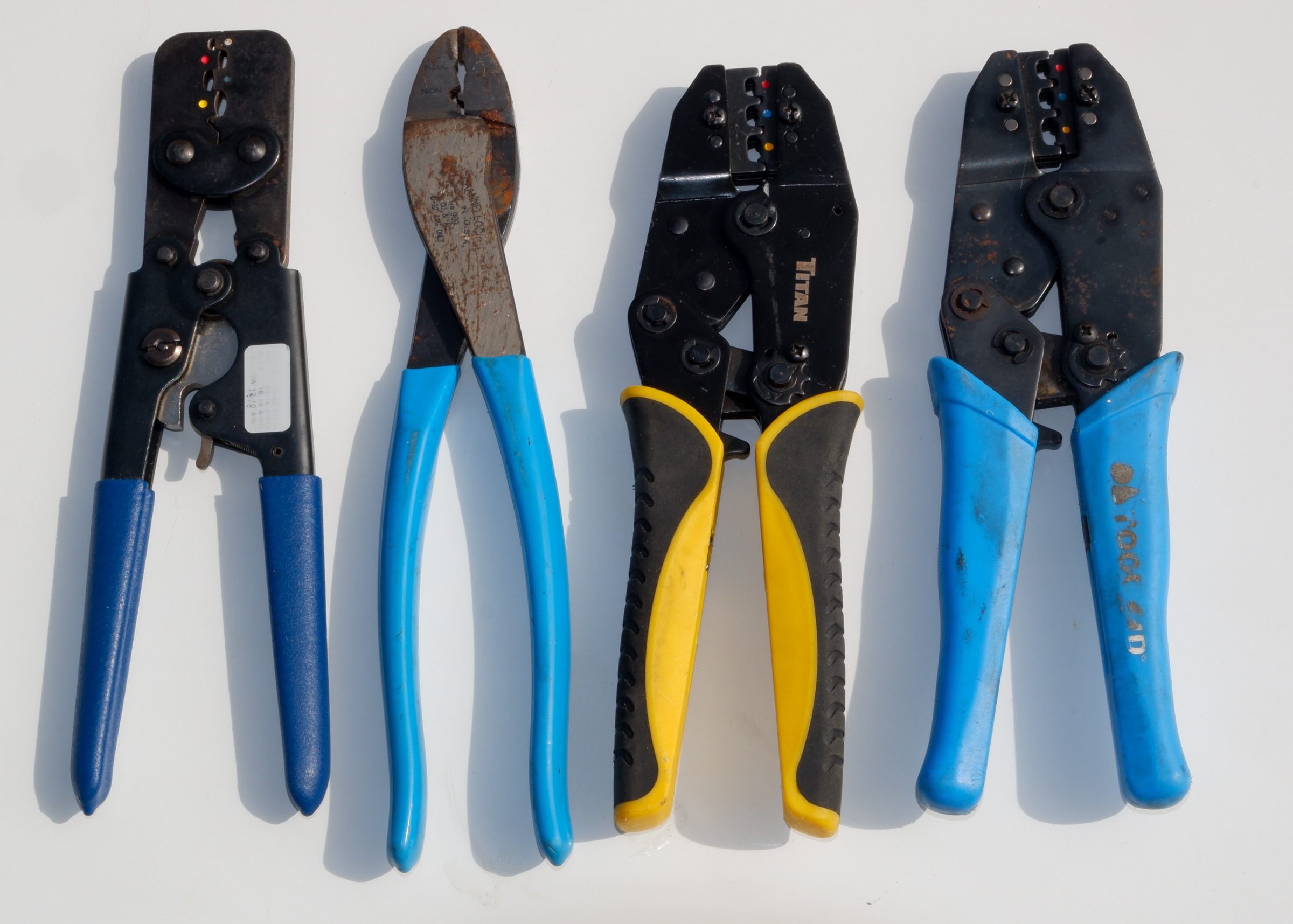







I had problems when the wires were different sizes,I had a couple of bad connections.I think if the wires are all the same size it might be ok.
My main concern is how the wire wedges down in the contact plate,a solid wire stays the same diameter,a stranded wire could thin and separate strands out as it is pushed down into the contacts,leaving less contact area.
This could all be quibbling…I might have to check these out again at least for wires of same gauge.
These connectors have their origins in telephone cable splicing and are probably over 50 years old. The issue with stranded wire is that as the blade pushes through the insulation stranded wire may not be rigid enough for the insulation to be properly cut. The contact may be poor and intermittent. It may test at zero resistance with an ohm meter but when you put more current through it the limited contact surface may be inadequate.
Thanks, Brian, but that conventional wisdom does not explain why some Scotchloks are certified by 3M to be good for both solid and stranded wires. The 801 and 314 models discussed above are specified that way by 3M and are sold as marine connectors to be used with stranded wire. You can download the 3M Marine catalog here and see several Scotchlok models:
http://solutions.3m.com/wps/portal/3M/en_US/Marine/Home/Products/AAD-Catalog/
So what is the difference between marine certified Scotchlok models and all the other models? I can’t figure it out. It’s not the anti-corrosive goo nor the doubled U-contact features, both of which seem good for marine use. Incidentally, while the basic Scotchlok idea has been around for decades, several of these features and models seem to be relatively recent developments.
BTW, For quite a while Tim over at NavaGear has been happily using Scotchlok UR2 connectors for NMEA 0183 connections:
http://www.navagear.com/2008/05/12/crazy-nmea-wiring-ais-2-way-dsc/
http://www.navagear.com/2011/05/13/vesper-ais-watchmate-installation-its-working/
Ben, I can perfectly see why you like these connectors as I have been in this spot many times. I am really tempted to use them with small wire gauges (i.e., NMEA0183 wires where this is still needed).
As I have seen the cheapo blue tee-connector fail many times, I used to have an aversion to anything “tee” – like “you don’t tee anything, ever!” I was surprised to find that my 1998 Jeanneau had no tee in it whatsoever from the yard. Instead, in some cases, they put two wires into a single terminal before crimping – so no additional connectors to form a tee. Also, they were not afraid to run huge lengths of redundant wiring from the switch panel to avoid a tee 20 feet down the line (the boat was built using pre-fabricated wire looms).
There were several tees put in by installers under the first owner but I have over the years ripped out every last bit of previous installer’s work (like cables dropped in the bilge). So since I started with a completely tee-free boat, I tried to keep it up. To be able to do this, I accumulated a good selection of common and more esoteric crimp terminals over the years. See here:
https://www.wuala.com/Henning_Duerr/Photos/Panbo/20131230_2.JPG/?key=jpfZjtFgeZBX
(disclaimer: in a few places (maybe 10 total), I have used the “tee” connector in the bottom center)
Using these terminals, I would have (and have) cut off those terminals of the motor panel into which you have tee’d and used a new crimp terminal identical to the one cut off, but with two wires crimped in it, the original and my new one.
I hope that I would have had in my selection the terminal needed for the multi-connector in the bottom center of your picture. If not, I would have gone in search for them.
But when it comes to small wired I am not really happy with my work so far, see here:
https://www.wuala.com/Henning_Duerr/Photos/Panbo/20131230_1.JPG/?key=jpfZjtFgeZBX
The crimp connectors used here are far to large for the small wires so I needed to fold the stranded wire back several times. I had to use pliers to insert the terminals and if I ever wanted to open them, I might rip the wires out from having to use too much force.
I think that this is the right place for the connectors covered in this entry and when I get around to it, I will get some to add to my collection. And when I do, I won’t worry about a missing certification.
BTW, the butt connector in my picture like the ones you describe here came with an Airmar sensor to be used in a breakout box with NMEA0183 and NMEA2000 wires. It says “3M” on it. So that’s kind of an endorsement by Airmar, isn’t it?
Also, off topic and only because I just did this yesterday: I don’t like the LTW NMEA2000 field attachable connector seen here:
https://www.wuala.com/Henning_Duerr/Photos/Panbo/20131230_3.JPG/?key=jpfZjtFgeZBX
The shield wire is bare and would surely have touched the screw of the blue center data wire if I hadn’t noticed it and put some shrink tubing over it. And it may not have touched (and thereby disabled the entire bus because of a shorted data wire) after completing the install but only after hours of use just when I need the instruments the most.
Or during the first days of a passage with many more to go when I am hanging over the railing every 15 minutes and would absolutely hate to crawl into lockers head down to troubleshoot.
Ben, you are off the hook. My deckboss, who happens to be master CATV tech with 35 years experience and 40 years of sailing under his belt, swears by them as well. They work, plain and simple, and are better than most non-overkill solutions for the life of a piece of equipment.
I think these are a marvelous solution for small wire butt connections, especially situations where one has multiple wires coming together. There simply isn’t a way to seal a heat shrink crimp connector when one has to have more than one wire coming in an end. The alternative is to have a terminal strip in a sealed box with gland fittings for wire entry.
I sense the question of whether a Scotchlok connector consistently can carry sufficient current is a red herring for the vast majority of applications.
Don
Great to hear some support for Scotchloks. I plan some more experiments in the lab this winter and some long testing on the boat. They’re also inexpensive, especially the smaller ones. At Allied, for instance, the UY2 model well suited for NMEA 0183 connections are about $13 per hundred.
And special thanks to Henning for sharing so many connector details.
I did consider replacing the gauge wire terminals, Henning, but then decided that minimal tampering with the working gauges was the wise way to go, plus there were so many different terminals involved.
Also, I think that your suggestion about shrink wrapping the center post on your field attachable N2K connectors applies to every brand of connector I’ve seen. The idea first came up in a comment to this entry:
https://panbo.com/archives/2009/09/adventures_in_nmea_2000_wiring_part_ii.html
I worked with the Scotchlok for 30 years @ Telstra and the enemy of them was water ingress through the button cap or between the wire and insulation from a break in the insulation sheath, which allowed the water to travel between the insulation and the wire from another location some hundreds of metres away. This caused corrosion to the untined copper wire and eventual high resistance between cutter bar and the wire itself which was a single core 0.40 conductor. Prior to leaving, I had worked out that by simply tinning the wire before ofering it to the connector this stopped the corrosion between the dissimilar metals. Oh and one other thing, wire movement and vibration are anothe enemy of them you have to make sure the wires and connector are well clamped to stop them cutting through multiple stranded wire, hence the tinning. Hope some of this guff helps. Kev the Liney
Ben,
I’ll give you one thing, when you investigate something, you REALLY get into it! I’m curious as well if there is any functional difference between the “marine-approved” and non-approved Scotchlok’s – in fact, I didn’t realize until now that 3M actually does claim that some are suitable for stranded wire. My inclination is that the issue identified by BrianW is probably valid, and pretty difficult to prove or disprove without a magnified lab experiment! It does stand to reason, however, especially when dealing with very small gauge wire (e.g. 24-26 AWG) that doesn’t have a lot of strands to begin with. You may have unwittingly corrupted your own test however, when you “stripped off the insulation, thinking that might better reveal how the connector didn’t have a solid grip on the stranded 24 gauge wire”. If the issue is a problem with the U contact penetrating the insulation of stranded wire, then you have effectively side-stepped that process by your test method.
I’m also curious what testing 3M actually performed in regards to these products, before “approving” them for stranded wire and marine use. I would feel a lot more comfortable if that approval came from ABYC or some other recognized agency that actually performs independent testing for marine products – rather than perhaps the marketing department at 3M.
You may be right – and maybe we will start seeing them used during commissioning and retrofits from reputable boat yards. But, anecdotal comments notwithstanding, I’m not quite ready to go there yet…
Thanks, Grant, but I tested various gauge wires both stripped and unstripped. No problems. In fact the top photo shows 4 pairs of unstripped 24AWG Scotchloked for an 0183 connection. I couldn’t put a meter across those connections but the data flowed fine.
If you check out the datasheet for the Scotchlok 314 connectors that 3M sells for marine use and that I used on my running lights, they are UL Listed and also CSA Certified. Their stated wire range sounds pretty boaty:
“22-14 AWG Solid or stranded, tinned or untinned
(0,5-1.5 mm 2 ) copper conductors. For use with
common thermoplastic insulated wires: T, TF, TFF,
TFN, TFFN, AWM, TEW, SAE-GPT with a maximum
insulation diameter of .150 inches (3,8 mm). Maximum
recommended current for general purpose applications: 22 AWG – 3 AMPS, 20 AWG – 5 AMPS, 18 AWG – 7 AMPS, 16 AWG – 10 AMPS, 14 AWG – 15 AMPS.”
Thanks, Ben –
I did actually check out the datasheet, and I saw their “stated” wire range. I’m just not sure I buy it. They may claim various non-marine approvals, like CSA, but call me the eternal skeptic – I’m not convinced it’s enough to throw out all my Ancor connectors and heat gun just yet.
Call me old-school, but until these become commonplace in the retrofit market, as far as I’m concerned – the jury’s still out.
Great job on the research nonetheless! – Happy 2014,
I found the 314 and 804 in the catalog but the UR2 and UB2 I can’t see.
Ben-
Why not call 3M’s 800# and get their answer directly? They will connect you to any product department and even to engineers if that’s what it takes to get you the detailed answer.
They used to call the old Scotchloks “guillotine” connectors because of the way the metal bit was slammed down on the wire. And that cutting action, aided with vibration, can eventually cut a wire. If the wire is not properly matched to the guillotine slot size, it cuts even faster. I’d suspect that with stranded wire, there might also be an issue with the outer strands cutting, and the inner wire coming free, unless the “blade” was fashioned and fit properly.
3M tends to be very conservative about their recommendations, but they’ve usually got good reasons. Give ’em a call, the 800# is on every box or can they sell.
Correctly soldered, hot glue gun & heat shrink to tidy, is my preferred option.
Here is an alternative that looks like it would be much more secure and weathertight: http://www.posi-lock.com/positite.html (marine version)
Review of the normal Posi-Lock:
http://www.webbikeworld.com/Reviewed-motorcycle-products/posi-lock/
While I agree that an Ancor adhesive heat shrink crimp is the best choice, these should be suitable under an instrument panel for small/short leads.
John,
Does the Posi-Tite have a product that will do 22-24ga wire? I am moving my Autopilot and several gauges which are really fine wire.
I got clear butt splices that are the right size but my crimp tool will not do them. So I am solder/shrik wrap each connection.
Looks like the Posi-Tite only goes down to 18-20 ga, but the Mini Posi-Lock goes down to 20-26 ga.
http://www.posi-lock.com/shoponline.cfm#12
You could put a tiny bit of sealer on the wire as in step 2 of the Posi-Tite directions before you slide cap down and screw it on.
Maybe Butyl or battery post sealer spray? Not sure.
What are the thoughts about using the clear crimp-style wire nuts? I was watching a AV installer crimp many 24ga wires using them and it seems like they crimp very similar to the traditional butt splice.
Do you mean the Posi-xxxx connectors? Whatever, thanks for the reminder. I checked out John K’s link while travelling and meant to buy some to test when I got home. Now I’ve done it.
Some of the Posi wire-nut style looked more interesting to me than the water-tight items, but none are clear or crimped, come to think of it. Can you link to what you’re talking about, Henry?
http://crimpsupply.com/20-16-ga-clear-crimp-style-wire-nuts.html?gclid=CM2Sz6OSubwCFW1nOgodxRQAAg
Okay, I’ve seen those before. But they’re spec’ed for 16-20 gauge wire and I think our main focus here is smaller stuff (since conventional crimped and adhesive shrinked butt connectors rule the roost for larger wires).
I couldn’t find smaller crimp wire nuts on that site, but if they exist I’d guess we’d have a pretty darn quick and decent boat connection. Especially if we could squirt in a little of that moisture displacing goo some ScotchLoks use.
Raymarine packt the 3M connectors in the box of the GPS Antenna a couple a years ago, I used them several times and in the end I opend up the ceiling of the boat to cut them away because of a bad connectoin. Maybe my fault but I liked the idea I soldered the ends tried everything but no sigar. Nowadays i use the wago clamps a lot and the work great not water proof , but there are sprays for that issue.
Whats your fingers closing the clamb
http://global.wago.com/en/products/product-catalog/terminal-blocks-connectors/installation-connectors/compact-splicing-connectors-all-conductor-types-222-series/index.jsp
Thanks, tcy. The Wago 222 lever nuts do look interesting. They can suppossedly handle stranded or solid wires 12 to 28 gauge and come in two, three, and fire wire versions. All with excellent Amazon ratings:
http://www.amazon.com/Wago-222-412-LEVER-NUTS-Conductor-Connectors/dp/B003K0J4IQ/ref=pd_sim_indust_2
However, wire stripping is required, there are no inline tap versions, and they have no waterproofing.
By the way, I’ve heard about that Raymarine situation several times but never with specifics about which 3M Scotchloks were provided. They vary a lot in design, as explained in the entry, and it’s wierd that older models approved for stranded wire and marine use don’t seem as good at it as newer models without those approvals.
Working as an electrician I’ve developed a strong skepticism about any IDC (Insulation Displacement Connector) Some of the fist commercial use of IDC technology was modular receptacles and switches in mobile homes.
On the up side these units get UL listing because, because the connection are tightly encased in fire retardant plastic, they seldom seem to cause fires. Poor long term reliability is not considered a major problem. After taking a couple of dozen of those units apart I have a good idea of how they fail.
The issue is that the slotted plate that cuts its way through the insulation and makes the electrical connections is quite thin and relatively sharp. This means that during installation, and with any vibration, movement, or normal heating under load, they get pressed tightly into the copper conductors, which forms stress risers then weaken the wire. Also the contact areas are quite small. Under load the connection warms up which causes the copper to migrate. Given a few years of load cycling and the connections can loosen to the point where light are dimming and receptacles can lose power when a door is slammed.
I’ve seen the cutter bar lose strength and loosen enough to cause arcing under load. I’ve seen where they have cut into the copper to the point where the copper fatigued and broke. Ive seen what looked like good connections overheat and go bad when heavily loaded. I assume this is a result of the small contact area.
I have used the small IDC units you are talking about for doorbells, telephone lines, and low voltage relay systems. All are low voltage and low current systems and systems seldom exposed to a whole lot of vibration and mechanical stress. They seem to last well enough. Then again, if they fail, it isn’t usually a major problem.
I have profound doubt as to their suitability if there is any significant load or if the wiring is subject to vibration and movement, like you might get on a boat. Working on boats I try to keep in mind that, unlike landlocked situations, most every control and data system on a boat has a life-safety role. Failure of low voltage control wiring might keep the critically needed engine, navigation, or communication systems from functioning. Lose any of those systems at an inopportune time can ruin your whole day.
IMHO the IDC technology isn’t suitable for any critical system, it has too many failure modes, and too many ways a connection to seem fine but suddenly fail. On the other hand those Posi-Tite connectors look foolproof. On critical systems, pretty much everything on a boat, sealed crimps with heat shrink are the accepted standard. On military systems we used to use set-screw connectors:
http://www.idealindustries.com/products/wire_termination/lugs/set_screw_connector.jsp
They have advantages. The connection is easily inspected for tightness, integrity and corrosion. The connections are easily reworked with simple tools to modify systems, make repairs, or rig temporary work-arounds. They are great for test systems were you have to substitute components frequently. Removing the insulating cap gives you a handy and durable test point for troubleshooting. They can be reused many times if you don’t go nuts tightening the set-screw. Tightened down on copper conductors they resist vibration very well but to be doubly sure you can put a small drop of Lockite on the set screw once tightened. We used to apply a little silicone brake grease to help keep the brass free of corrosion in hostile environments.
Oh Panbo, how I love thee…
This past weekend I installed a Standard Horizon GX2150 VHF, a Ram-3 microphone, and a pair of Morad VHF-156 HD antennas on my boat. After a few unsuccessful attempts at running the Ram-3 cable through a small conduit full of wires, I decided to cut it, run it, and splice the wires.
I remembered this Panbo post on the 3M connectors but I could not find the 3M connectors locally. Thankfully, I managed to find Ideal IDCs at a local home depot (http://www.idealindustries.com/prodDetail.do?prodId=insulation-displacement-connectors&div=2&l1=connectors).
Splicing the wires could not have been easier. I now have a second, high quality VHF that displays AIS targets on my two Garmin chart plotters.
Raul
Panbo loves you too, Raul!
Bear in mind, though, that those IDC connectors seem to be the same as some of the Scotchlok models discussed above, including the fact that they are only rated for solid copper wire. Some people think they won’t work, or won’t last, when used on a boat with stranded wire.
However, I just used the Scotchlok UY butt connectors to install the new LED sidelights mentioned in today’s entry:
https://panbo.com/archives/2014/07/simrad_rs35_vhf_hs35_wireless_handset_testing_pretty_well.html
They were fast and fit inside the routed groove on the back the trailboards. That exposed spot will also be a good test of how they hold up and I happen to have digital monitoring on Gizmo’s running light current so I’ll know if they fail. Test begun.
Ben,
Thanks for the comments.
I understand the concerns that some have expressed. I believe that the stranded wire connections made with IDCs will last, provided there is adequate protection and strain relief. In my installation I used a combination of small tie wraps and high quality electrician’s tape to do this.